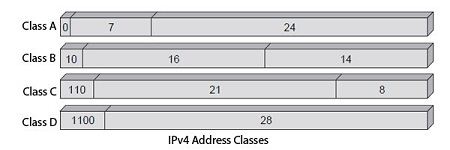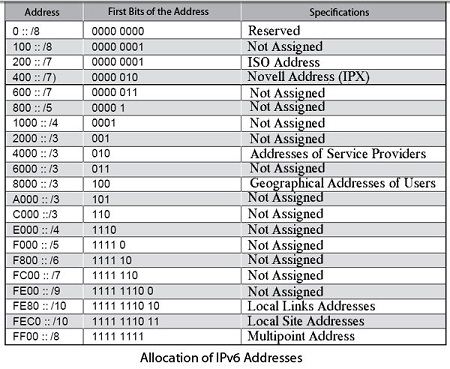As the Internet is a network of networks, addressing, is particularly important. This section provides an initial overview of the addressing problems through the first generation IP protocol IPv4 and IPv6 new generation.
Internet machines have an IPv4 address represented on a 32-bit integer. The address consists of two parts: a network identifier and an identifier of the machine to the network. There are four classes of addresses, each for encoding a different number of networks and machines:
• Class A: 128 networks and 16,777,216 hosts (7 bits for networks and 24 for hosts);
• Class B: 16,384 networks and 65,535 hosts (14 bit and 16 for networks for hosts);
• Class C: 2,097,152 networks and 256 hosts (21 bits for networks and 8 for hosts);
• Class D: group addresses (28 bits for the hosts belonging to the same group).
These addresses are detailed in Figure.

The IP addresses were defined to be processed quickly. Routers that perform the routing based on the network number are dependent on this structure. A host connected to multiple networks has several IP addresses. In reality, not just an address identifies a machine but a connection to a network.
To ensure the uniqueness of the network numbers, Internet addresses are assigned by a central agency, the NIC (Network Information Center). One can also define its own addresses if one is not connected to the Internet. However, it is strongly advised to get an official address to ensure interoperability in the future.
As IPv4 addressing is somewhat limited, we had to propose an extension to cover the needs of 2 years extension 000. This address is often presented as the rationale of the new version of IP, while there is only one of several reasons.
The IPv6 address takes 16 bytes. The number of potential addresses allowed by IPv6 exceeded 1023 for each square meter of the earth’s surface. The difficulty of using this huge reserve Address is the representation and the rational use of these 128 bits. The representation is carried out by 16-bit group and is in the following form:
123: FCBA: 1024: AB23: 0: 0: 24: FEDC
Address series equal to 0 may be abbreviated by the symbol ::, which can only appear once in the address. Indeed, this sign does not indicate the number of successive 0 to deduce this number by looking at the address, the other series can not be abbreviated.
The IPv6 addressing is hierarchical. An address allocation (that is to say a breakdown between potential users) has been proposed, the Table provides details.

 Dinesh Thakur holds an B.C.A, MCDBA, MCSD certifications. Dinesh authors the hugely popular
Dinesh Thakur holds an B.C.A, MCDBA, MCSD certifications. Dinesh authors the hugely popular